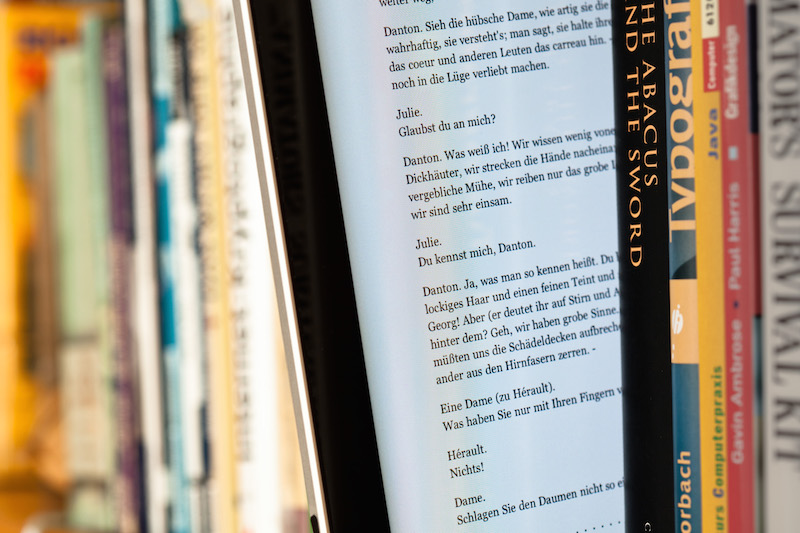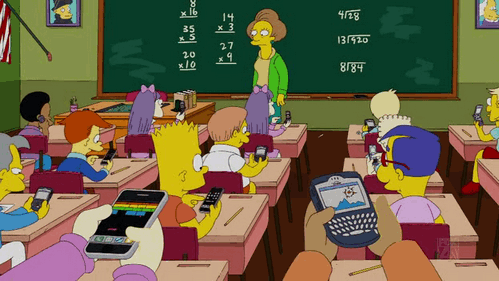
Ebook between paper books by Maximillian Schnöherr. Used under CC BY-SA 3.0 license.
The Classroom: Hyper writing and the Literacies of School
In order to investigate the most current claims that a new literacy crisis has emerged as a result of the rise of digital technology, it is important to examine the current communicative practices of students themselves. Andrea Lunsford (2010) in “Our Semi-Literate Youth? Not So Fast,” provides a useful starting point for our discussion. She writes, “If we look beyond the hand wringing about young people and literacy today… we will see that changes brought about by the digital revolution are just that—changes.” As noted earlier, Hayles argues that common discursive practices should be considered as examples of hyperliteracy, or, more specifically, hyper reading and writing; that is, such practices should be understood as a new type of literacy—part of the changing shapes of writing and communication in the digital age—rather than evidence of a lack of literacy. Lunsford uses the example of student writing to illustrate that while students compose in a wide range of digital and traditional environments, many students can negotiate these varying rhetorical situations effectively. She provides an example of a student text message replete with abbreviations and emoticons in contrast to an elegantly written and entirely appropriate report written by the same student in a professional situation. Lunsford argues that this student can easily differentiate between different purposes, audiences, and environments to compose successfully both with a mobile communication device and within the context of a conventional professional situation. She uses this example to make the claim that “young people for the most part are aware of the context and audience for their writing” and that they can make the changes necessary to communicate successfully in different situations.

Lunsford notes that her study focuses on Stanford students and doesn’t deny the ways in which this influences her project and the conclusions she draws from it. As someone who has taught at both an elite (top 12) liberal arts college and a regional comprehensive university, I can say with great confidence that the students Lunsford describes are not the students at my current institution. This doesn’t necessarily mean that her conclusions apply only to students at Stanford or similar elite institutions. It does seem necessary to investigate this issue further in relation to this other kind of non-elite student, however. With this in mind, a preliminary examination of student literacy practices at a regional comprehensive university suggests that students indeed have facility with common hyperliterate practices. When those practices are held to the standards of conventional literacy or academic literacy, however, they often may appear at best to fall short, or at worst, to be “uncivil” or even “rude.” That is, in contrast to Lunsford’s positive claims about general student ability to negotiate amongst situations, composing environments, and audiences, it may be that while less academically prepared students are both literate and hyperliterate, they have a harder time negotiating between the mobile communication practices with which they are comfortable and the “traditional” conventions found in academic or professional literacies. This does not mean that elite students always avoid writing “uncivil” emails, or that these students fail to benefit from a course teaching the conventions of professional electronic correspondence. Both elite and first-generation college students may encounter difficulty when attempting to navigate between “school literacies” and the conventions of electronic communication. However, under-represented and first-generation students, who lack a middle or upper-class background, do enter college with less preparation in school literacies than the upper-class students who make up the majority of the student population at elite college and universities. Those students who lack preparation in academic literacies, and who may also lack what people like Allan Bloom and E.D. Hirsch call “cultural literacy,” are more likely to encounter difficulty when attempting to move back and forth amongst the conventions of mobile electronic communication and those of academic communication, electronic or otherwise. For example, as the director of composition, I have seen numerous examples of student writing (for an academic course) at my university that contain instances of text-message jargon (e.g., “2” rather than too, “U” rather than you). While this evidence is anecdotal, it does suggest that some of the students at my institution have a difficult time shifting from the kind of composing with which they are comfortable and familiar to composing in a manner deemed acceptable by the academic discourse community.
An important question to ask here is whether the outcry and crisis narrative, in the academy and otherwise, that emerges in response to a proliferation of indecorous emails and essays containing text message jargon, is really about concern over a decline in the functional literacy and/or school literacy of young people, or represents, rather, a concern over a decline in the cultural literacy of young people. That is, are the professors and pundits who worry over the writing ability of students who tend to compose according to the conventions of mobile communication environments, really concerned about the ability of these students to become functionally or academically literate adults? Or, are those who drive the crisis narrative really more concerned about the lack of cultural literacy—that is, a lack of knowledge and respect for how one is expected to “properly” communicate, as established by the canon of Western literature, philosophy and rhetoric—that an indecorous, text message-like email supposedly indicates? In fact, much of the latest literacy crisis narrative can be understood as alarm over the belief that students who write essays or emails that include text message jargon are displaying a lack of class.
The Context
Before continuing, it is important to contextualize the experiment in relation to the particular institution where it was conducted. This trial was done at a mid-sized (approximately 12,000 students) regional comprehensive university. The school is the most diverse in its state, both in terms of race and class. Many of its students come from lower to lower-middle class backgrounds, as just under 40% of students come from families that make under $50,000 a year. In the 2008-2009 school year, 72% of students received financial aid. Continue reading ...
The Experiment
A preliminary experiment was conducted with a group of students enrolled in an experimental writing lab offered through my university's Writing Center (which I also direct). The writing lab was offered to a group of students from a freshman Bridge program (another experiment) and most students took the lab in conjunction with either the university's basic writing course or introductory first-year composition course. Continue reading ...
Early Findings
1. Many students did not alter, or only minimally altered, the messages sent using different technological applications (SMS and email) and tools (mobile device and desktop computer).
2. A number of students produced text messages that were more successful than their corresponding emails.
3. Most students took my directions very literally and sent very simple messages, rather than crafting messages likely to generate useful feedback, particularly given the constraints of each technological tool in use.
4. Student writing displayed little evidence of audience awareness, regardless of communication technology used.Continue reading ...